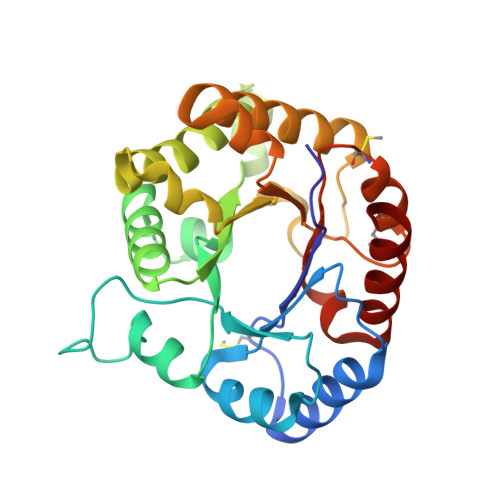Determining the molecular mechanism of inactivation by chemical modification of triosephosphate isomerase from the human parasite Giardia lamblia: A study for antiparasitic drug design.
Enriquez-Flores, S., Rodriguez-Romero, A., Hernandez-Alcantara, G., Oria-Hernandez, J., Gutierrez-Castrellon, P., Perez-Hernandez, G., Mora-Ide, L., Castillo-Villanueva, A., Garcia-Torres, I., Mendez, S.T., Gomez-Manzo, S., Torres-Arroyo, A., Lopez-Velazquez, G., Reyes-Vivas, H.(2011) Proteins 79: 2711-2724
- PubMed: 21786322
- DOI: https://doi.org/10.1002/prot.23100
- Primary Citation of Related Structures:
3PF3 - PubMed Abstract:
Giardiasis, the most prevalent intestinal parasitosis in humans, is caused by Giardia lamblia. Current drug therapies have adverse effects on the host, and resistant strains against these drugs have been reported, demonstrating an urgent need to design more specific antigiardiasic drugs. ATP production in G. lamblia depends mainly on glycolysis; therefore, all enzymes of this pathway have been proposed as potential drug targets. We previously demonstrated that the glycolytic enzyme triosephosphate isomerase from G. lamblia (GlTIM), could be completely inactivated by low micromolar concentrations of thiol-reactive compounds, whereas, in the same conditions, the activity of human TIM (HuTIM) was almost unaltered. We found that the chemical modification (derivatization) of at least one Cys, of the five Cys residues per monomer in GlTIM, causes this inactivation. In this study, structural and functional studies were performed to describe the molecular mechanism of GlTIM inactivation by thiol-reactive compounds. We found that the Cys222 derivatization is responsible for GlTIM inactivation; this information is relevant because HuTIM has a Cys residue in an equivalent position (Cys217). GlTIM inactivation is associated with a decrease in ligand affinity, which affects the entropic component of ligand binding. In summary, this work describes a mechanism of inactivation that has not been previously reported for TIMs from other parasites and furthermore, we show that the difference in reactivity between the Cys222 in GlTIM and the Cys217 in HuTIM, indicates that the surrounding environment of each Cys residue has unique structural differences that can be exploited to design specific antigiardiasic drugs.
- Laboratorio de Bioquímica-Genética, Torre de Investigación, Instituto Nacional de Pediatría, Secretaría de Salud, 04530, México, D.F.
Organizational Affiliation:




















